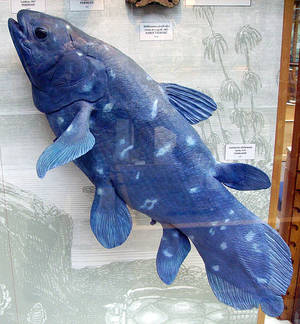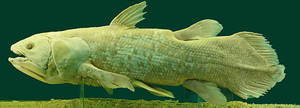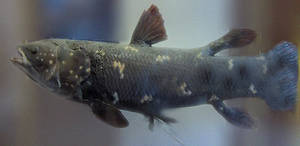The Story of the Coelacanth
Interview with
Paul - It was a chance encounter. It occurred in December, 1938 for the first time. What happened there was there was a South African trawler coming into harbour on the day before Christmas. When it came into harbour the captain of the trawler contacted Marjorie Courtenay-Latimer at the East London Museum and she came down to the harbour. She went on deck and there was a pile of fish on deck. She shifted them about a little bit and then she said she saw this wonderful blue. She had the first specimen of the living coelacanth to be found. She saw this lovely fish, put it in a taxi, took it back and then sent a letter down to J.L.B. Smith. J.L.B. Smith was a chemistry professor at Rhodes University but a well-known ichthyologist. He recognised the sketch and thought it was a coelacanth. He announced this to a disbelieving world at that time.
 Meera - Why was this finding so incredible? What was so special about this fish?
Meera - Why was this finding so incredible? What was so special about this fish?
Paul - First of all, it was very special because coelacanths were known to ichthyologists but they were only known as fossils in the fossil record. The latest or the most recent fossil was about 70 million years old. When this came out there was a gap of 70 million years between the known fossil record and this living specimen: stunning. Stunning because it was of a living lineage or great interest to ichthyology. It's got unique features that no other living fishes have.
Meera - This is a fish that would have been living at the time of the dinosaurs.
Paul - Oh yes. It goes right back to Devonian times, 400 - before the dinosaurs. It's endured the ages of the dinosaurs and everything else. The lineage has survived, not necessarily the species but the lineage.
Meera - What marks it as a unique species, this coelacanth?
Paul - there are a number of special features and these are displayed in this specimen which we have dissected to show some of these features and some of which aren't even obvious with that dissection. The fins, for example, if you look at the structure of several of the fins they are unique in having a limb. That is very unusual. In fact the structures of those limbs are predecessors in a way to tetrapod limbs. They've got the bone structure of a tetrapod.
 Meera - Is this why it then has the nickname of 'fourlegs?'
Meera - Is this why it then has the nickname of 'fourlegs?'
Paul - Oh yes. Without doubt. That gave it its famous nickname of 'fourlegs.' It looks like they've got legs and not fins as other fishes.
Meera - This is a very large fish. I'd say this particular specimen is over a metre, maybe a metre and a quarter long?
Paul - Yes. This is not the largest specimen on record but it is a full-gown adult. They get pretty big, up to round-about two metres in length. That's the height of a man. They get up to 100kg in weight so they are big fishes.
Meera - With this particular specimen here you've cut out a section to show its internal organs. What's so special about the organs of this fish?
Paul - This shows a notochord. That's that tube that you see exposed in the midsection there. Instead of the bony backbone like you or I have this species has a pneumatic tube. It's like a hosepipe. It extends right from the head right to the tip of the tail. That tail form is also very unique for these fishes. You won't find another fish with a tail like that.
Meera - What makes the coelacanth extra special is that, as you say, it hasn't changed over time. Its form and its structure has remained fairly constant. Why do you think this is?
 Paul - If you look at the fossil record there are fossil coelacanths that are almost identical in form to the modern coelacanth. It hasn't changed structurally very much over time. Why not? Well, the pressure's to do so probably aren't there. In other words it's probably maintained a lifestyle very similar to the one we observe in the modern day coelacanth for that long time. Although other coelacanths were found in other habitats, for example in estuaries, the body form that requires quiet waters and lives in caves, it manipulates and lives in small groups - all those features probably held over a long period of time.
Paul - If you look at the fossil record there are fossil coelacanths that are almost identical in form to the modern coelacanth. It hasn't changed structurally very much over time. Why not? Well, the pressure's to do so probably aren't there. In other words it's probably maintained a lifestyle very similar to the one we observe in the modern day coelacanth for that long time. Although other coelacanths were found in other habitats, for example in estuaries, the body form that requires quiet waters and lives in caves, it manipulates and lives in small groups - all those features probably held over a long period of time.
Meera - Where do you find this fish? Where does it live?
Paul - We now know that the coelacanth is widespread in the East African coast. They've also been found in Indonesia, about ten years ago a single specimen was reported and then a subsequent specimen was actually collected. We suspect we don't know the full story of their distribution but it's much more widespread than we believed previously.
Meera - What do you think the information we know about the coelacanth and the fact that it existed so long ago can help us understand more about in science?
Paul - There's lots it can tell you. It's a lineage of vertebrate diversity that is not represented anywhere else. That particular lineage and the features of it - anything we learn and know about it is going to assist our understanding of life on Earth, obviously. There are many features even in the embryogenesis - why have they retained a notochord? Those simple questions, all obvious questions start allowing us to ask some of the developmental and evolutionary questions. Some of the features are advanced. Behavioural studies - how do they survive, what do they feed on? What are the population dynamics? How do they communicate? They're so widespread in the Western Indian Ocean and they're not given to being strong swimming forms (in other words out in currents) how do they disperse? All these questions are going to assist us understanding life in the marine world if nowhere else.
- Previous The Crisp Packet Fireworks Show!
- Next Protecting The Black Rhino










Comments
Add a comment